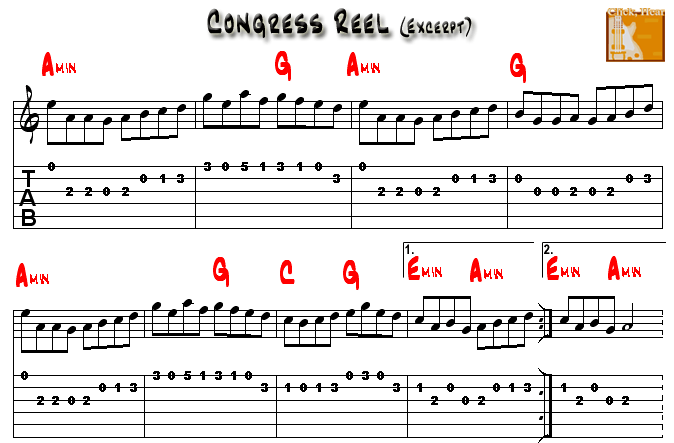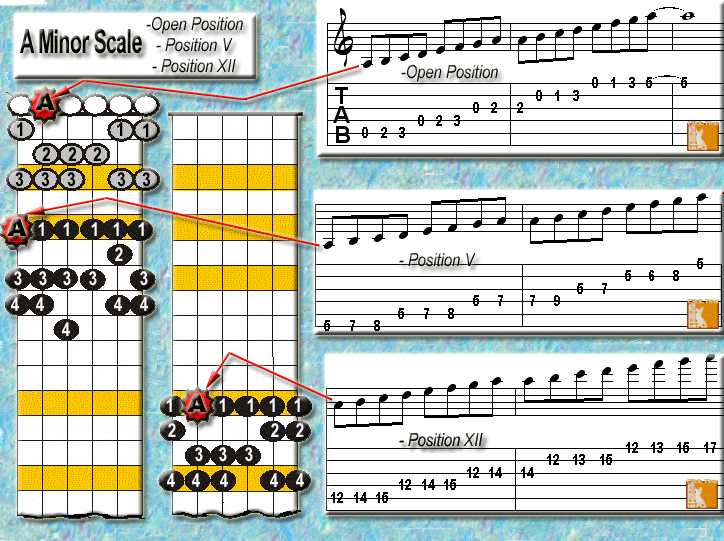As we expand on the level of understanding we gained concerning minor scales in LESSON 7, we’ll be keeping 3 keys in mind:
1.  The theory behind the minor scale. Although there are many minor scales in our modern system of music, the most important minor scale, and the one we’ll study in this lesson is called the Natural minor.
The theory behind the minor scale. Although there are many minor scales in our modern system of music, the most important minor scale, and the one we’ll study in this lesson is called the Natural minor.
The 2 other names for the Natural minor you’ll see are (1) the Pure minor and the (2) the Aeolian mode. Usually the is simply called The Minor Scale.
The minor scale, like all scales, is spelled and theoretically thought of , in relation to the Major scale. Think of a minor scale as a Major scale with a flatted 3rd, 6th & 7th degree. With the 3rd, 6th & 7th degree of the Major scale flatted, half steps in the new scale, the minor scale occur between notes 2 & 3 and also between notes 5 & 6.
In the case of the A Major Scale, the naturally occuring 3rd, 6th & 7th degrees are named C#, F# & G# respectively. What may be a little confusing is that flatting a note which is already a sharped note results in a natural note. In the Key of A, a flatted 3rd is a C natural not a C flat.
2.  The sound of the minor scale. The Natural minor is oftten thought of sad sounding. You may also think of the Natural minor as being dark, mysterious and mournful. Our first example below is a traditional
The sound of the minor scale. The Natural minor is oftten thought of sad sounding. You may also think of the Natural minor as being dark, mysterious and mournful. Our first example below is a traditional
Irish fiddle tune called the Congress Reel. Pay special attention to its haunting melodic sound quality. To an experienced musician, this type of musical quality, or coloring if you will is very easily identifiable as a natural minor scale.

To further learn the sound of the minor (e.g. Aeoloian Mode, Natural minor) play this brief excerpt from In The Hall Of The Mountain King by Edvard Greig. Again the mysterious and haounting quality is quite evident. As is common practice, the piece below features a few notes not in the scale, labeled as chord tones, to accomodate the use of strange and unusual chords and harmonies. The basic flavor and musical character of this melody is still however decidedly minor.

3.  The shapes and patterns asscoiated with the Natural minor scale. Earlier in the course, (Lesson 7, minor scales) we learned to play a Root 6 minor scale and a Root 5 minor scale. The basic idea is that you use these two positions as your ‘first line of defense’ as this Root 6 and Root 5 thinking
The shapes and patterns asscoiated with the Natural minor scale. Earlier in the course, (Lesson 7, minor scales) we learned to play a Root 6 minor scale and a Root 5 minor scale. The basic idea is that you use these two positions as your ‘first line of defense’ as this Root 6 and Root 5 thinking
is the certainly the most effective, and most widely adapted approach in organizing the neck of the guitar. Play all three of the scale patterns below until you can play each of the 3 positions quickly and fluidly from memory. Your also learning the qaulity and character of the Natural minor scale.

5 Positions……
There are a total of 5 seperate fingering patterns for any minor key, leaving us 3 new patterns to memorize. Of course, all 3 of these new fingering patterns are going to be thought of in relation to an “A ” Root notes locate on strings 6 & 5 (and in one case, string 4). Again, you may find it helpful to think of these scale pattens as containing certain A minor chord shapes.
- Playing with just a few notes of the each pattern.
- Playing Root note and two other scalee tones.
- Playing chord tones.
- Try just the first 4 or 5 notes of the scale.
All these smaller, easie skills are adding up to and leading up to the day when youi can quickly breeze through any of the 5 scale patterns, and create many original musical ideas in each of these 5 shapes
Guided Practice……
 To complete the lesson we’ll be doing visualuzations and learning scale patterns for each of the 5 minor scale shapes we’re studying in this lesson.
To complete the lesson we’ll be doing visualuzations and learning scale patterns for each of the 5 minor scale shapes we’re studying in this lesson.
Conclusion……
In this lesson you’ve learned to deal with minor scales with interlocking fingering patterns, enabling you to play all over the neck soloing in or playing a piece in a minor key.
As a setting for melodic playing and lead playing the minor scale has a very tuneful and warm quality, all the while being able to sound dark, sad, mystereious or contemplative. In music, the minor sound or minor quality is the opposite of the Major sound with its bright and happy capabilities.